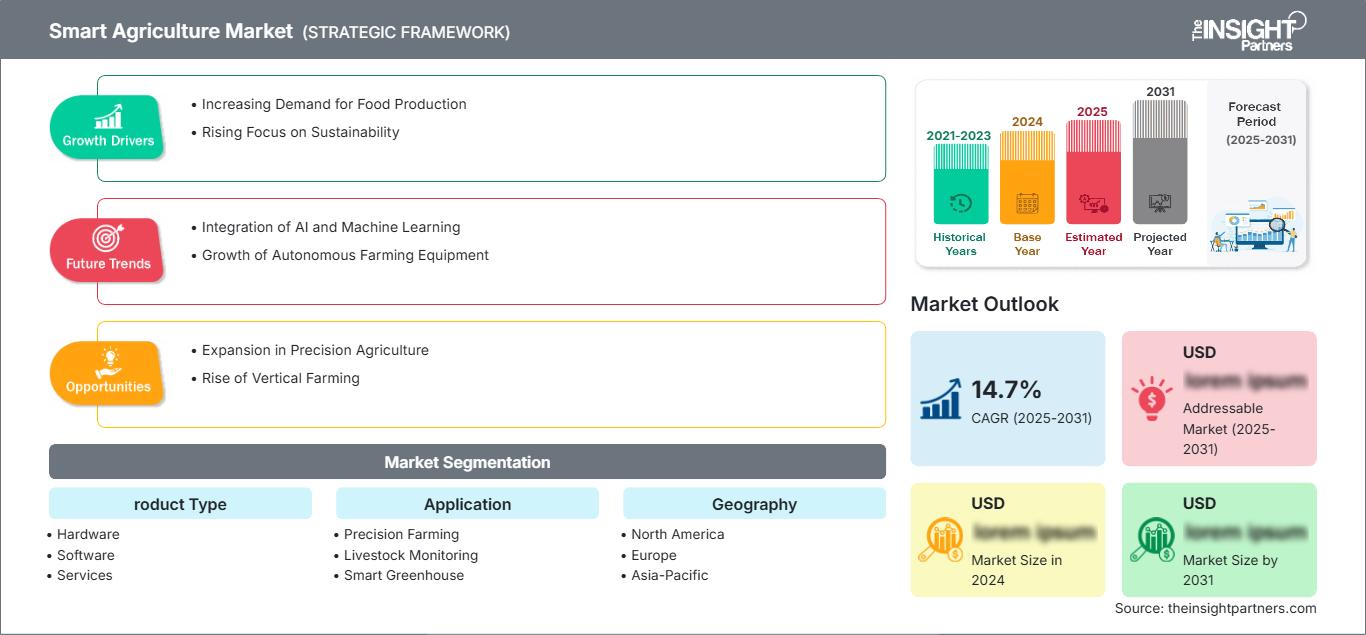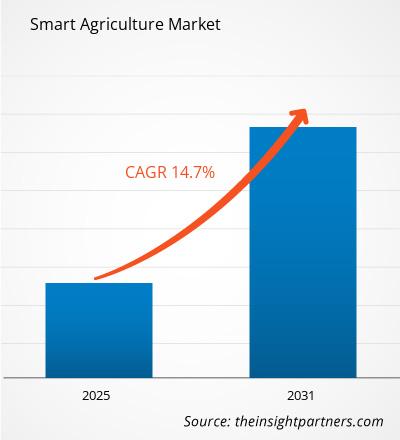页面已更新 :
Jan 2025
预计从 2025 年到 2031 年,智能农业市场复合年增长率将达到 14.7%,市场规模将从 2024 年的 XX 百万美元扩大到 2031 年的 XX 百万美元。
该报告按产品类型(硬件、软件和服务)和应用(精准农业、牲畜监控、智能温室等)细分。全球分析进一步细分为区域和主要国家。该报告以美元为单位提供了上述分析和细分的价值。
报告目的
Insight Partners 撰写的《智能农业市场》报告旨在描述当前的格局和未来的增长、主要驱动因素、挑战和机遇。这将为各种业务利益相关者提供见解,例如:
- 技术提供商/制造商:了解不断变化的市场动态并了解潜在的增长机会,使他们能够做出明智的战略决策。
- 投资者:对市场增长率、市场财务预测和整个价值链中存在的机会进行全面的趋势分析。
- 监管机构:规范市场政策和警察活动,旨在最大限度地减少滥用,维护投资者的信任和信心,并维护市场的完整性和稳定性。
智能农业市场细分产品类型
- 硬件
- 软件
- 服务
应用程序
- 精准农业
- 牲畜监控
- 智能温室
- 其他。
自定义此报告以满足您的要求
您将免费获得任何报告的定制,包括本报告的部分内容,或国家级分析、Excel 数据包,以及为初创企业和大学提供超值优惠和折扣
智慧农业市场: 战略洞察

-
获取本报告的主要市场趋势。这个免费样本将包括数据分析,从市场趋势到估计和预测。
智能农业市场增长动力
- 粮食生产需求不断增长:随着全球人口快速增长,粮食需求空前高涨。精准农业、物联网传感器和自动化机械等智能农业解决方案有助于优化耕作方式,满足这些需求。这些技术使农民能够提高作物产量、减少浪费并改善资源管理,从而满足对更高效的粮食生产系统的需求,以满足世界不断增长的人口的需求。
- 日益关注可持续性:由于气候变化、资源枯竭和环境恶化,可持续性正成为农业领域的主要关注点。智能农业技术通过优化用水、减少化学品投入和最大限度地减少浪费,帮助农民采用更可持续的做法。无人机、土壤传感器和自动灌溉系统等技术可以实现更高效的资源管理,在保持生产力的同时促进环境管理。
智能农业市场未来趋势
- 人工智能与机器学习的融合:人工智能 (AI) 和机器学习 (ML) 越来越多地被融入到智能农业系统中。这些技术分析从传感器、无人机和卫星收集的大量数据,为农民提供切实可行的见解。人工智能和机器学习可以预测天气模式、优化种植计划、检测害虫并加强作物管理,从而提高决策能力和整体农场效率。
- 自主农业设备的增长:自动驾驶汽车和机械的采用是智能农业的一个发展趋势。配备 GPS 和传感器的拖拉机、收割机和无人机正变得越来越普遍。这些自主系统降低了劳动力成本,提高了准确性,并实现了全天候作业,使农民能够以最少的人工干预优化种植、施肥和收割等田间操作,从而提高生产力并降低运营成本。
智能农业市场机遇
- 精准农业的扩展:精准农业是智能农业最重要的机遇之一。通过使用 GPS 导航拖拉机、无人机和土壤传感器等先进技术,农民可以以前所未有的细节程度监测和管理农作物。这可以提高农作物产量,减少浪费,并更有效地利用水和肥料等投入,为农业技术领域创造巨大的增长潜力。
- 垂直农业的兴起:垂直农业是一种创新方法,允许农作物在堆叠层或受控环境中种植,为智能农业技术提供了重大机遇。照明、温度、灌溉和养分输送的自动化系统对于最大限度地利用空间和提高效率至关重要。随着城市化的发展,垂直农业可以为当地的粮食生产提供解决方案,降低运输成本并确保全年都有新鲜农产品。
智能农业市场区域洞察
The Insight Partners 的分析师已详尽阐述了预测期内影响智能农业市场的区域趋势和因素。本节还讨论了北美、欧洲、亚太地区、中东和非洲以及南美和中美洲的智能农业市场细分和地域分布。
智慧农业市场报告范围
| 报告属性 | 细节 |
|---|---|
| 市场规模 2024 | US$ XX million |
| 市场规模 2031 | US$ XX Million |
| 全球复合年增长率 (2025 - 2031) | 14.7% |
| 历史数据 | 2021-2023 |
| 预测期 | 2025-2031 |
| 涵盖的领域 |
By 产品类型
|
| 覆盖地区和国家 |
北美
|
| 市场领导者和主要公司简介 |
|
智慧农业市场参与者密度:了解其对商业动态的影响
智能农业市场正在快速增长,这得益于终端用户需求的不断增长,而这些需求的驱动因素包括消费者偏好的演变、技术进步以及对产品优势的认知度的提升。随着需求的增长,企业正在扩展产品线,不断创新以满足消费者需求,并抓住新兴趋势,从而进一步推动市场增长。

- 获取 智慧农业市场 主要参与者概述
主要卖点
- 全面覆盖:该报告全面涵盖了对智能农业市场的产品、服务、类型和最终用户的分析,提供了整体格局。
- 专家分析:该报告基于对行业专家和分析师的深入了解而编写。
- 最新信息:该报告涵盖了最新信息和数据趋势,确保了业务相关性。
- 定制选项:此报告可以根据特定客户要求进行定制,并适合业务策略。
因此,智能农业市场研究报告可以帮助引领解码和理解行业情景和增长前景的道路。尽管可能存在一些合理的担忧,但本报告的总体优势往往大于劣势。
- 历史分析(2 年)、基准年、预测(7 年)及复合年增长率
- PEST和SWOT分析
- 市场规模、价值/数量 - 全球、区域、国家
- 行业和竞争格局
- Excel 数据集
近期报告
客户评价
购买理由
- 明智的决策
- 了解市场动态
- 竞争分析
- 客户洞察
- 市场预测
- 风险规避
- 战略规划
- 投资论证
- 识别新兴市场
- 优化营销策略
- 提升运营效率
- 顺应监管趋势
我们的客户































87-673-9708

ISO 9001:2015





 获取免费样品 - 智慧农业市场
获取免费样品 - 智慧农业市场